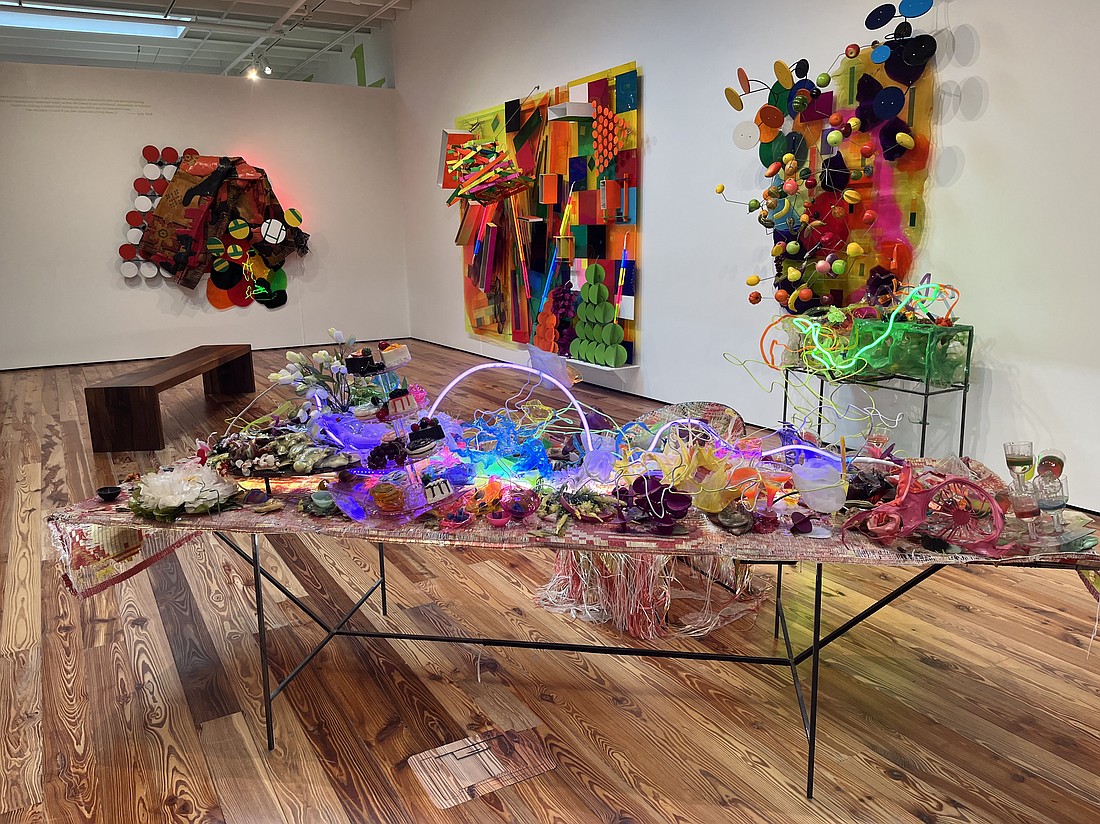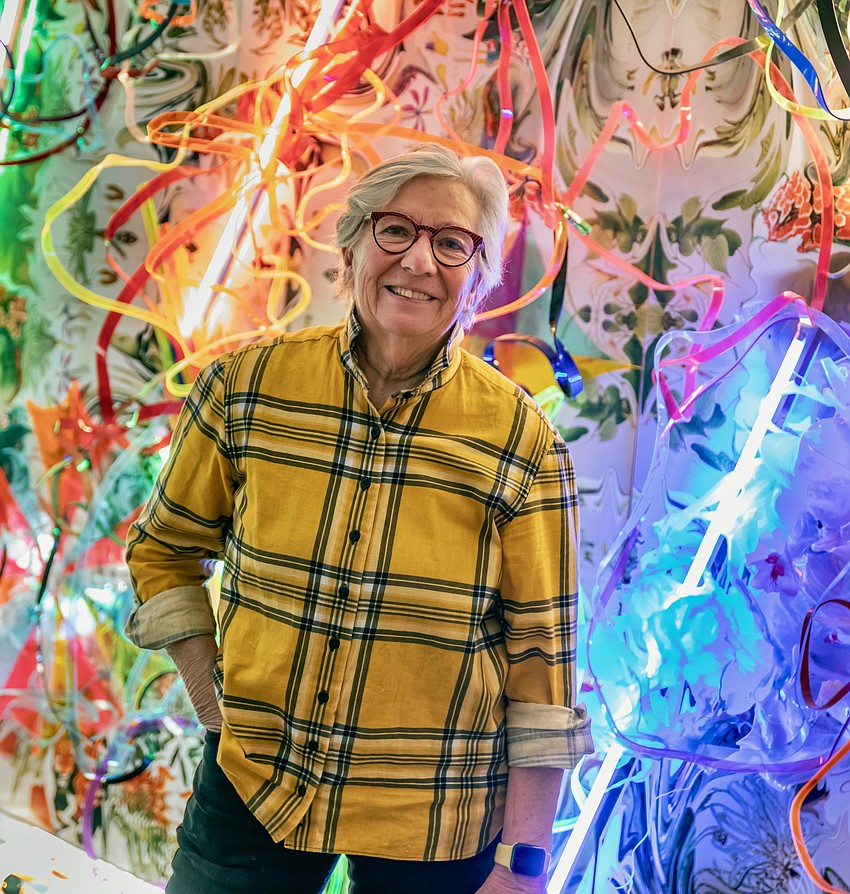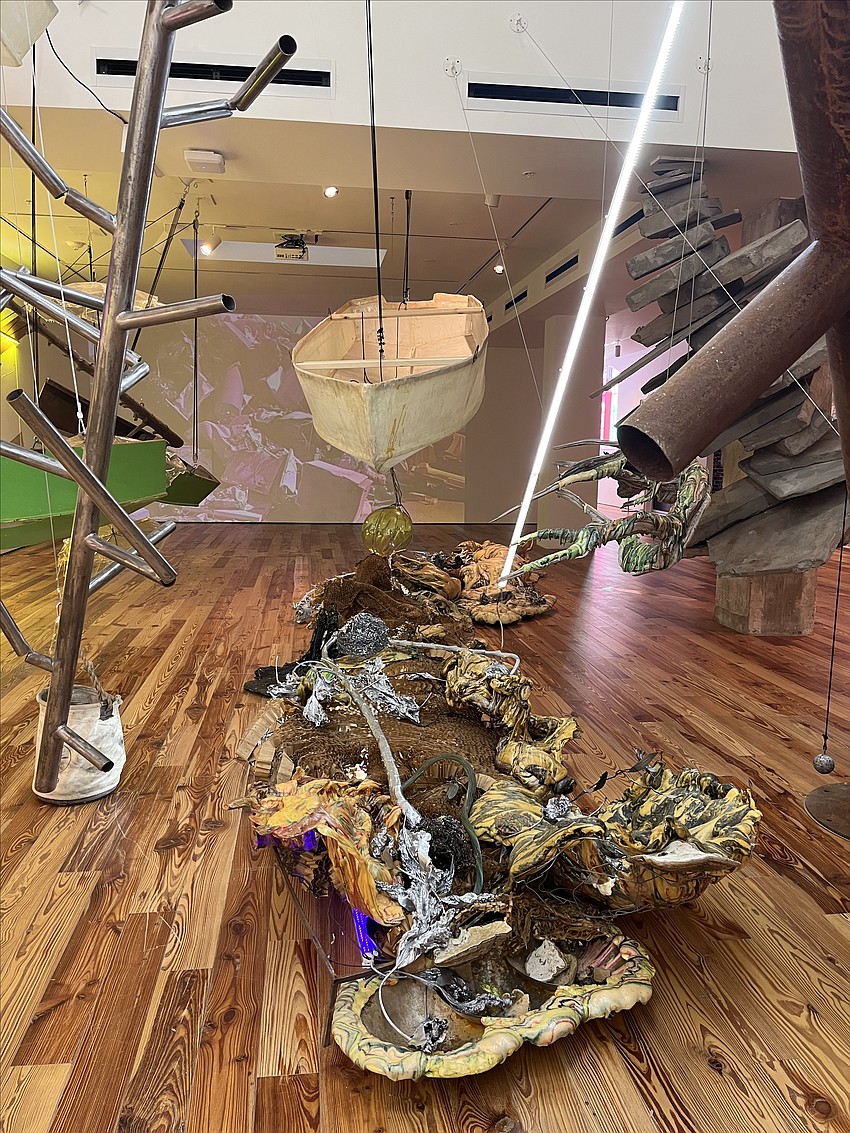- July 26, 2024
-
-
Loading

Loading

Is it possible to create beauty out of the remnants of destruction?
Yes, says artist Judy Pfaff.
You can decide for yourself at Pfaff's exhibition, "Picking Up the Pieces," which runs through March 24 at Sarasota Art Museum.
The show has a schizophrenic feel. One half is an exploration of the aftermath of Hurricane Ian's September 2022 landfall. Pfaff saw Ian's impact firsthand when she visited Fort Myers and Sanibel Island after the storm.
The other half of the exhibition is a dizzying riot of color. Walking through the artworks cobbled together from salvaged odds and ends feels like going to a garage sale after taking LSD. (That observation is based on portrayals in books and film, not personal experience.)
It's Pfaff's own Magical Mystery Tour, to riff on The Beatles, bringing together pieces both old and new. It's a retrospective of sorts for Pfaff, whose career of more than five decades has included over 100 solo exhibitions. It has also produced artwork that resides in the permanent collections of MOMA, Whitney Museum of Art, Tate Gallery, Brooklyn Museum of Art and Detroit Institute of Arts.

Pfaff lives in Tivoli, New York, and has been an art professor at Bard College for 30 years. But she has a long history with Sarasota. Her first show here was in 1981 at the John and Mable Ringling Art Museum.
She was also present during the birthing process of the Sarasota Art Museum, a contemporary art museum that officially opened in 2019 after many years of effort by its 13 founding members and a partnership with Ringling College of Art & Design.
Among SAM's founders were Peppi Elona and Wendy Surkis, whose names adorn the SAM lobby.
Pfaff has dedicated "Picking Up the Pieces" to Elona, an artist and arts advocate who died in May 2023 at her home on Siesta Key. During an interview, Pfaff said she considers Surkis a "good friend" and that she is surprised that Elona's art hasn't gotten more international recognition.
The word "amazing" gets thrown around so much these days that it has nearly lost its meaning, but it's an understatement to say that Pfaff has had an amazing life.
She was born in London in 1946 in the wake of World War II and lived there until she was 12. German bombing missions, collectively known as the Blitz, left the city in ruins but in a checkerboard fashion, with one house flattened and the one next door left standing.
Americans are familiar with this phenomenon because hurricanes and tornadoes often take the same willy-nilly path.
Told by an interviewer that she's been "picking up the pieces" since day one, Pfaff remarks that SAM Senior Curator Rangsook Yoon, who curated Pfaff's exhibition, made the same observation.
Later on in life, Pfaff would witness destruction again when she lived three blocks away from where the World Trade Center's Twin Towers collapsed on Sept. 11, 2001.
Pfaff came to the United States by way of Canada, where she landed after marrying a U.S. Air Force officer 12 years her senior at the tender age of 16. She ended up leaving him to escape from married life in Sweetwater, Texas.
Her husband would be the first in a line of male mentors who would help Pfaff navigate life, education and career. Pfaff says she went to four different colleges for her undergraduate studies, a period of her life she calls "helter-skelter."
"My attendance was spotty and I didn't care much for authority," she says. "But I was always working. I like to work, especially in my studio at night."
After graduating in 1971 from Washington University in St. Louis, where she earned a bachelor's of fine arts, Pfaff ended up in summer school at Yale University. It was here that she met Abstract Expressionist painter Al Held, who was from Brooklyn. Pfaff calls Held, who died in 2005, the "smartest guy I ever met."
Pfaff says she got into Yale’s master’s program by the skin of her teeth. At the time, she was simply a painter, not the multimedia artist that she would become. Today, she is a sculptor, carpenter, welder, glassblower, printmaker and designer. She credits her seamstress grandmother for helping to spark her creativity at a young age.
"At Yale, the education was so odd," she recalls. "It was very formal, all men. You would bring your paintings down into this pit to be critiqued. People would be looking down from higher levels into this pit. As a student, you were not allowed to speak."
It wasn't long after earning her MFA that Pfaff stopped painting and started exploring other media. But she was influenced by Held's success and knew that she wanted to be an artist whose works were displayed in museums.
After Held, another mentor helped change the direction of Pfaff's life. He is Leon Botstein, the president of Bard College, who hired her as co-chair of the studio arts department in 1994.
Nestled in New York's Hudson Valley, Bard is a prestigious, pricey (tuition is $62,790 a year) and, some way would say, pretentious college that attracts mavericks and future artistic superstars.
Among them was Donald Fagen, who met his Steely Dan co-founder Walter Becker at Bard, and famously sang he was "never going back to my old school." He did go back to Bard, though, to accept an honorary degree in 1985.
With its eclectic faculty and talented students, iconoclastic Bard College has proven to be an ideal hothouse for Pfaff's artistic growth. In academia, it's not unusual for faculty to stay put because of the security of tenure, but Pfaff says she has remained at Bard for 30 years because it's given her the opportunity to build an arts program, create her own art in a studio provided as part of the job and because she likes the environment.

When Pfaff was hired, "this school wasn’t good in arts," she recalls. "Now it's world class in the arts. I helped escalate it. Here, the faculty treats the students like artists."
It's a far cry from those demeaning days at Yale, when a female art student wasn't taken seriously and none of the students was allowed to weigh in during critiques.
When you talk to Pfaff, it's hard to place her undefinable accent. I assumed she was Scandinavian until she told me she was born in England. Because she spent time with an Irish family as a child, Brits think she sounds Irish.
Like her art, Pfaff's voice is a pastiche of accents.
Pffaff is surprisingly modest. She'll tell you how she drank with pilots as a young wife in Newfoundland, worked on an English farm and became involved with the Rudolf Steiner movement in elementary education (not in that order). But in the course of an hour, she fails to mention that she is a recipient of a MacArthur Fellowship.
Commonly called a "genius grant," the fellowship comes with an $800,000 no-strings-attached stipend. Here's the thing: You can't apply for it. Someone has to nominate you. That means you or your work has made such a big impression that someone, even a stranger, has gone to the time and trouble to submit your name for the MacArthur Foundation's consideration.
With "Picking Up the Pieces," Pfaff is looking back on her life, parsing it, trying to figure out the patterns, mourning the losses and reveling in the joys.
There are no titles for the pieces displayed at SAM, but visitors can take away a brochure written by Yoon that describes "Picking Up the Pieces." The pamphlet is more than a curator's description of an artist's exhibition. It's a love letter.
"Her work is a topography of human emotions, the nexus of countless storylines linking the events of our time to our personal and collective experiences," Yoon wrote.
Some who tour "Picking Up the Pieces" may see only a mishmash of artfully assembled junk. For others, the installation will hit home with its message of survival and the hope of creating a better life after the storm.